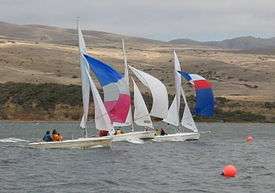Flying Scot (dinghy)
The Flying Scot is a day sailer dinghy used for pleasure sailing as well as racing throughout America. The Flying Scot was designed in 1957 by Gordon K. (Sandy) Douglass who had already designed the Thistle and Highlander dinghies. The name parallels the Flying Dutchman which was designed a few years earlier. It is manufactured by Flying Scot Inc. (originally the Gordon Douglass Boat Company), based in the western Maryland town of Deer Park.[1]
 Three Flying Scots finishing a race under spinnaker. | |
| Boat | |
|---|---|
| Crew | 2–3 |
| Draft | 1.2 m (3 ft 11 in) |
| Hull | |
| Hull weight | 306.5 kg (676 lb) |
| LOA | 5.8 m (19 ft) |
| LWL | 5.6 m (18 ft) |
| Beam | 2.0 m (6 ft 7 in) |
| Rig | |
| Mast length | 8.6 m (28 ft) |
| Sails | |
| Spinnaker area | 18.6 m2 (200 sq ft) |
| Upwind sail area | 17.65 m2 (190.0 sq ft) |
The Flying Scot is noted for ease of handling and durability. More than 6000 have been built of this design. The hull design of the Flying Scot makes it able to plane in winds of 15 knots or more, exceeding the waterline hull speed.
Races are held throughout the year in the United States by the Flying Scot Sailing Association and its local fleets. As a one-design, all Flying Scot boats are built to the same specifications and thus have equal sailing performance, no matter when the boat was manufactured. This makes the boats especially appealing to amateur racing associations since this type of construction strives to eliminate variables other than the skill of the crew. The Flying Scot was inducted into the American Sailboat Hall of Fame in 1998.
The Flying Scot Association says, "The Scot's performance offers thrills to even the experienced sailor and provides for tight, competitive racing. There are more than 100 fleets racing Flying Scots in the United States. The Scot is normally raced with a crew of two or three, but can be single-handed as well. It can also carry as many as eight adults. The sail plan consists of main, jib and spinnaker. Simple rigging and uniform construction fosters tactical racing."